Sometimes the information you get from guides and websites can be a bit incomplete. I’ve mentioned some of the more individualized websites such as Spotted by Locals, Atlas Obscura, and Amusing Planet that I regularly use in advance of my visits. By individualized I mean that these are not aggregate sites like Trip Advisor or, when it comes to food, sites such as The Fork or Yelp where you get reviews by scores of people but, rather these sites reflect the taste and experience of the individual writer.
I don’t remember where I’d first read about a restaurant called Nicolau but that site presented it as though it was an undiscovered gem. When I mentioned to my VRBO host Sérgio that I’d heard it was a terrific place to have breakfast, he agreed but told me to arrive early or be prepared to wait. He was right. The website was wrong. The restaurant was barely more than a block from his flat so I passed it often and, regardless of the time of day or night, it usually looked something like this
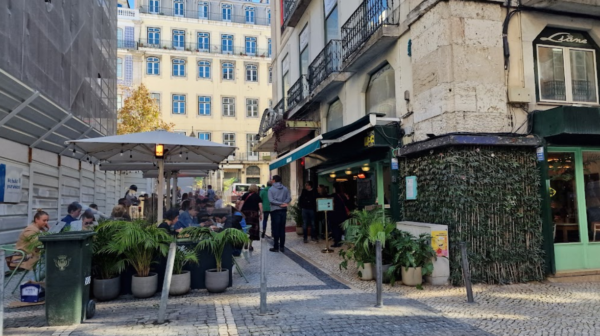
with the interior filled and a line of people waiting to get inside. This Friday I got there relatively early (closer to breakfast time than brunch) and was happy to sit outside thereby I avoiding the wait. (The market Meu Super Franqueiros where I did my first bit of grocery shopping is just half a block to the left of the building at the back of the photo.) For breakfast, I had a pancake, cannellini bean hummus toast with sautéed spinach and mushrooms, and a cup of tea. I think it came to about 13 or 14 euros.
After breakfast, I was off to one of Lisbon’s signature points, the Castelo de São Jorge (St. George’s Castle) that you’ve seen in many of my photos but that I didn’t visit my first time here.
Now it makes sense
During his somewhat hurried orientation Wednesday evening Sérgio told me about two places to buy groceries the one I went to yesterday and one called Pingo Doce that I’d get to by using an elevator and that was open either to match the hours of the store or the Castle – I don’t recall which. It sounded confusing to me until Friday morning when I walked from Nicolau along the Rua dos Franqueiros and saw
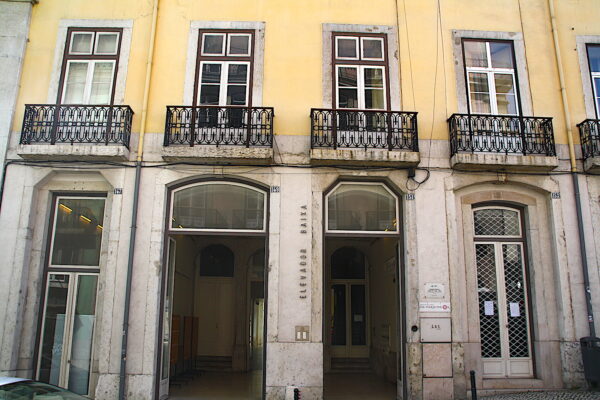
the Elevador Baixa. You walk through this lobby, take the elevator to the fourth floor, walk through another lobby onto Rua da Madalena, turn left, pass the small square, turn right and a few steps up the hill is the market.
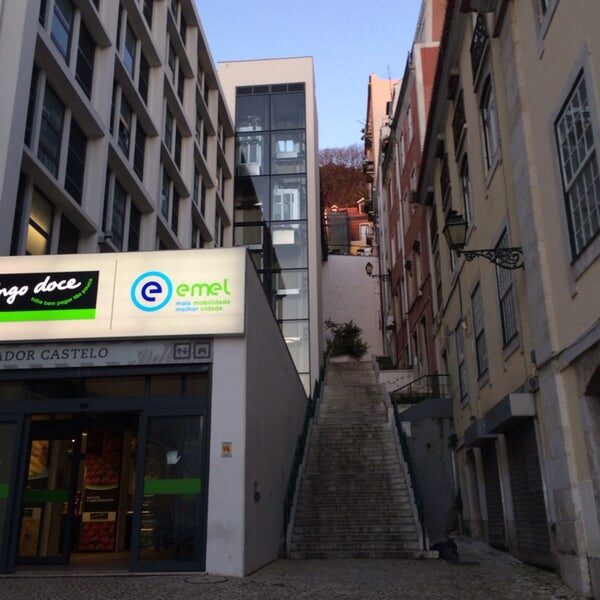
You’ll also notice in this badly framed picture that there’s a second elevator you can ride that saves you the several flights of stairs that lead you to the level of the orange house in the center of the picture. The day was young, I had plenty of energy, and had just finished a substantial breakfast so I chose the stairs. Using the two elevators saves 25 – 30 meters of climbing to get to the castle.
(In a previous post I mentioned my preference for the Organic Maps app. In addition to the fact that you’re not tracked, it has, in some instances, better data than Google Maps. This was one of those instances. When I asked Google Maps for walking directions from the flat to the Castle, it gave me this:
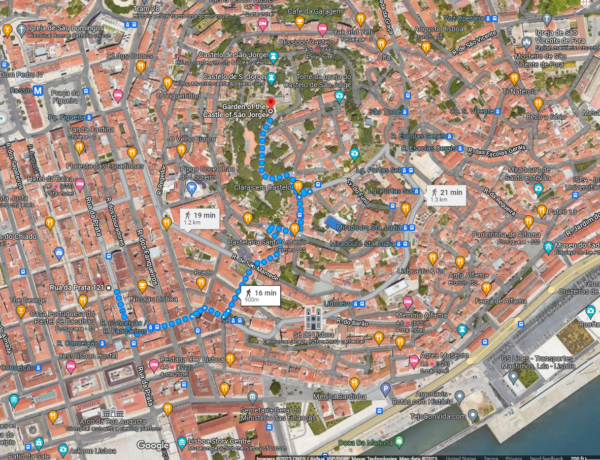
Organic Maps took me up the elevator which is both shorter – by about 150 meters – and easier especially if you ride both elevator segments.)
Can words express the feel of sunlight in the morning?
On my way to the Castle, I took a slight detour to stop at the Miradouro de Santa Luzia. (You can see it on the map a bit to the southeast of the Castle.) From there I had views like this
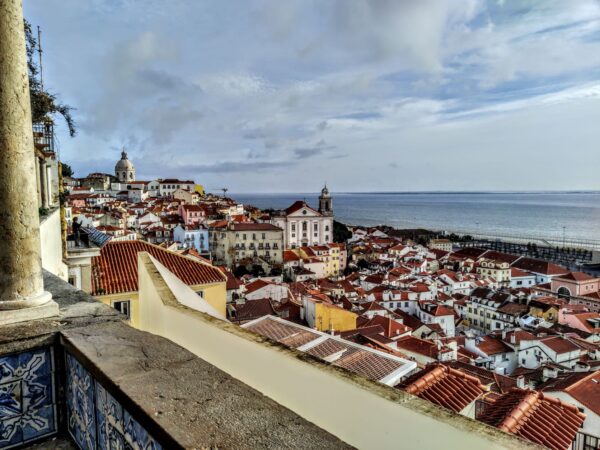
of the city and Tejo (Tagus) River. As I looped back toward the castle I began wondering how it came to be named for the patron saint of England. As it turns out, there are several links including the fact that Georgy Boy is, in fact, considered a patron saint of Portugal. I’ll have more on that below but first, let’s have a brief historical overview of the Castle.
As one of the highest points in Lisboa, it makes sense that it was both inhabited and fortified even in the city’s prehistory. The evidence of habitation – and likely military importance dates to the native Celtic and Iberian tribes in the 6th century BCE. The Romans left first evidence of fortification in the second century BCE.
The Visigoths supplanted the Romans in the early fifth century and held dominion over most of the Iberian Peninsula until they were ousted by the Moors in 711. Although Moorish rule outlasted the Visigoths by nearly a century and a half, Afonso Henriques, with the aid of a group of “Frankish Crusaders” drove them out of Lisboa in 1147 though the capital would remain in Coimbra for more than 100 years.
In 1255, Afonso III moved the capital to Lisboa with the Castle serving as the royal palace. Later King Dinis I made substantial improvements. The last last third of the 14th century was a momentous time for the nation and for the Castle. First as I wrote here,
On 16 June 1373 Edward II of England and Ferdinand and Eleanor of Portugal signed the first Anglo-Portuguese Treaty establishing “perpetual friendships, unions, and alliances” between the two nations.
Then,
In 1386, the Aliança Luso-Inglesa or Anglo-Portuguese Alliance so strongly reinforced the 1373 treaty that it is today the oldest known international alliance in recorded history that is still politically in force.
João I (King from 1385-1433), the first monarch from the House of Aviz and founder of the Joanine Dynasty,
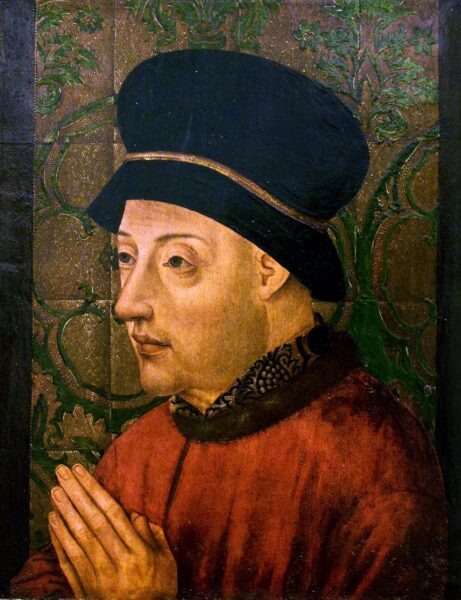
(Wikimedia – Public Domain)
had been appointed King by the Council of the Kingdom in Coimbra because his half-brother Ferdinand I died without a male heir and because João and his English allies together with his most loyal and effective general, Nuno Álvares Pereira, won the Battle of Aljubarrota over Juan I of Castille and his allies. João was the son of Peter I and a woman named Teresa. He married Philippa of Lancaster in 1387 and gifted the castle to his new wife. Some sources say his dedication of the castle to St. George was a commemoration of the 1373 treaty.
The Frankish (actually English) Crusaders who assisted Afonso I in his siege and ultimate victory in retaking Lisboa were likely responsible for bringing St. George into the Portuguese consciousness. Over the next century, Portuguese fighters generally cried Sant’Iago! as they rode into battle. However, it appears that during the reign of Afonso IV (1291-1357) São Jorge! replaced Sant’Iago! as the battle cry. Álvares Pereira, who was canonized in 2009 and is known as Santo Condestável (Saint Constable), was also devotee of St. George.
A little more travel advice
Although this will probably be less useful in the high tourist season, in December, it pays to arrive early at the Castle. I had only one person in front of me when I purchased my entry ticket and was able to move about the castle with considerable freedom and easily get unobstructed views like this one of the Terreiro do Paço (where I’ll be to celebrate the coming of the new year tomorrow night)

or this one looking at Chiado and the Convento da Carmo.
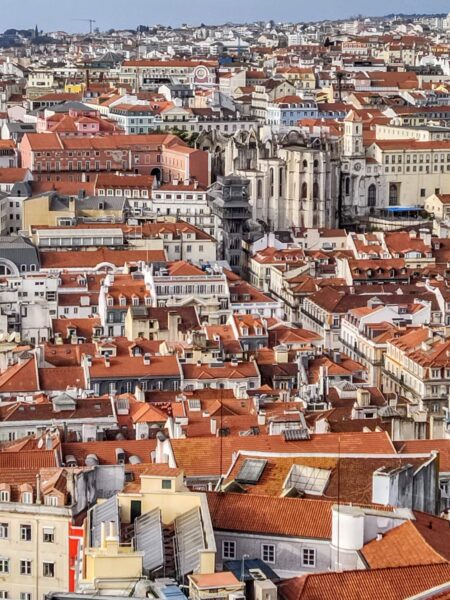
By the time I left some 90 minutes later, the line for tickets stretched more than a block.
And, if you’re wondering why someone who is generally obsessed with details has given such relatively short shrift to this important historic landmark, it’s because it’s the place and not the structure that’s important. You see, very little of the castle remained standing after the 1755 earthquake and nearly everything today’s visitors see and walk through is a reconstruction (or restoration, if you prefer) that’s little more than 70 years old as of this writing.
After a careful trip down the hill and a break for lunch, both of which you can imagine, I’ll take you back into Chiado for a visit to an unusual museum in the next post and then to that promised dinner you can eat anywhere but likely find an odd choice for a restaurant meal.
Beautiful views.
Do they make you want to come visit me next year? 😊